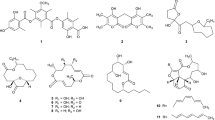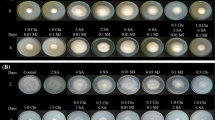Abstract
Colletotrichum acutatum has become an increasingly important plant pathogen worldwide. With this background, a study was carried out to characterize the toxicity of liquid culture media from different isolates and to identify some properties of the toxic principles. Liquid culture media from all isolates were toxic to rubber leaves and induced the anthracnose symptoms. Toxicity of the culture filtrate was not host specific and toxic substances were thermostable. Acetone soluble fraction of the culture filtrates retained the toxic activity and it was effective even at a concentration of 700 μg dry mycelium mass/ml.
Similar content being viewed by others
References
Henz GP, Boiteux LS, Lopes CA. Outbreak of strawberry anthracnose caused by Colletotrichum acutatum in central Brazil. Plant Disease 1992; 76: 212.
Howard CM, Mass JL, Chandler CK, Albregts, EE. Anthracnose caused by the Colletotrichum complex in Florida. Plant Disease 1992; 76: 976-981.
Simpson, DW, Winterbottom CQ, Bell JA, Maltoni ML. Resistance to a single UK isolate of Colletotrichum acutatum in strawberry germplasm from Northern Europe. Euphytica 1994; 77: 161-164.
Denoyes B, Baudry A. Species identification and pathogenicity study of French Colletotrichum strains isolated from strawberry using morphological and cultural characteristics. Phytopathology 1995; 85: 53-57.
Sato T, Ueda S, Iijima A, Tezuka N. Re-identification of pathogens of anemone and prune anthracnose. Annals of the Phytopathological Society of Japan 1996; 62: 170-174.
Simmonds JH. A study of the species of Colletotrichum causing ripe fruit rots in Queensland. Queensland Journal of Agriculture and Animal Science 1965; 22: 437-459.
Jayasinghe CK, Fernando, THPS, Priyanka UMS. Colletotrichum acutatum is the main cause of Colletotrichum leaf disease of rubber in Sri Lanka. Mycopathologia 1997; 137: 53-56.
Jayasinghe. CK, Wijesuriya BW, Fernando THPS. Multivariate analysis of vegetative and reproductive characters to authenticate Hevea isolate of C. acutatum, the major cause of Colletotrichum leaf disease of rubber in Sri Lanka. International Rubber Research and Development Board, Information Quarterly, Hertford, England, 1997; part 4: 17-18.
Jayasinghe CK, Fernando, T.H.P.S. Growth at different temperatures and on fungicide amended media: two characteristics to distinguish rubber isolate of C. acutatum from C. gloeosporioides. Mycopathologia 1998; 143: 93-95.
Fernando, THPS, Jayasinghe CK, Wijesundera RLC. Factors affecting spore production, germination and viability of Colletotrichum acutatum isolates from Hevea brasiliensis. Mycological Research (In press).
Fernando THPS, Jayasinghe CK, Wijesundera RLC. Cell wall degrading enzyme secretion by Colletotrichum acutatum, the causative fungus of secondary leaf fall of Heveu brasiliensis (rubber). Mycological Research (accepted for Publication).
Grove JF, Speake RN, Ward G. Metabolic products of Colletotrichumcapsici: Isolation and characterisation of acetylcolletotrichium and colletodiol. Journal of Chemical Society C: 230-234.
Ballio A, Bottalico A, Buonocore V, Carilli A, Vittorio, di V, Grant A. Production and isolation of aspergillomarasmin B (lycomarasinic acid) from cultures of Colletotrichum gloeosporioides Penz. (Gloeosporium olivarum Alm.). Phytopathologia Meditterranea 1969; 8: 187-196.
Sharma MC, Sharma BC. Toxic metabolite production by Colletotrichum gloeosporioides causing citrus die-back in India. Indian Phytopathology 1969; 22: 67-74.
Gohbara M, Hyeon SB, Suzuki A, Tamura S. Isolation and structure elucidation of colletopyrone from Colletotrichum nicotianae. Agricultural Biology and Chemistry 1976; 40: 1453-1455.
CAB PEST CD (1989-1999) Silver Plattes Information, CAB International, U.K.
Luke HH, Wheeler. Toxin production by Helminthosporium victoriae. Phytopathology 1955; 45: 453-458.
Goodman RN. Colletotin a toxin produced by Colletotin on tomato and Diglitalis foliage. Phytopathology 1960; 50: 325-327.
Lewis S, Goodman RN. Morphological effects of colletotin on tomato and Diglitatis foliage. Phytopathology; 1960, 52: 1273-1276.
Strobel G, Kenfield D, Sugawara F. The incredible fungal genus Drechslera and its phytotoxic ophiobolins. Phytoparasitica 1988; 16: 145-152.
Tanaka S. Studies on black spot disease of Japanese pears (Pirus serotina Rehd.). Memoirs of the College of Agriculture Kyoto University (Imperial) 1933; 28: 1-31.
Wheeler and Luke HH. Microbial toxins in plant disease. Annual Review Microbiology 1963; 17: 223-242.
Onesirosan P, Amy D, Durbin RD. Increasing sporulation of Corynespora cassiicola. Mycopathologia 1975; 55; 121-123.
Vidhyasekaran P, Ponnialar TR, Samiyappan R, Velazhahan R, Vimala R, Amanathan A, Paranidharan V, Muthukrishnan. Host-specific toxin production by Rhizoctonia solani, the rice sheath blight pathogen. Phytopathology 1997; 87: 1258-1263.
Author information
Authors and Affiliations
Rights and permissions
About this article
Cite this article
Jayasinghe, C., Fernando, T. Toxic activity from liquid culture of Colletotrichum acutatum . Mycopathologia 152, 97–101 (2001). https://doi.org/10.1023/A:1012436024102
Issue Date:
DOI: https://doi.org/10.1023/A:1012436024102




